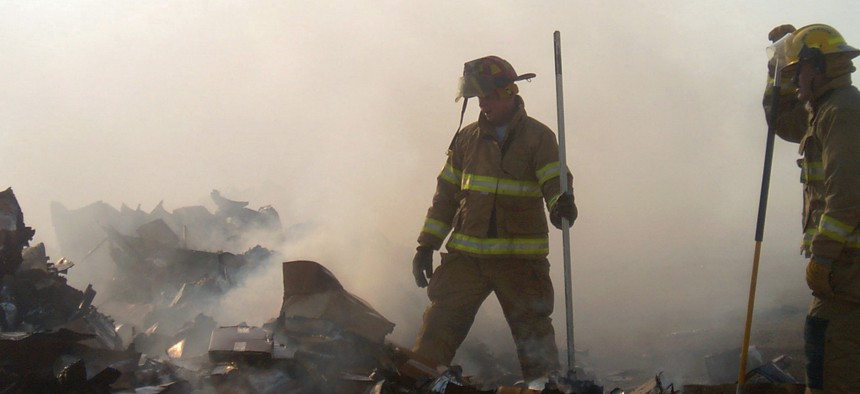
Two firefighters take a short break during a mop-up operation in a burn pit at a landfill on Forward Operating Base Speicher, near Tikrit, Iraq (IRQ), in support of Operation Iraqi Freedom. SSG David Fischer
Deployed Civilians Can’t Get Worker’s Comp — and That’s Bad News for a Military that Depends on Them
Thanks to a legal double standard, a civilian injured or sickened in a warzone has an impossible burden of proof.
It seems ill-advised to make working for the U.S. Defense Department less attractive during a war for talent, so it’s time to fix a particular legal double standard. Most DoD applicants are informed of the possibility of hazardous working conditions, especially overseas. Few are aware that if they become ill or injured while deployed, their subsequent quest to receive care, compensation, and benefits will require them to provide proof that the law says is impossible to obtain.
About 500,000 military veterans served in Iraq and Afghanistan. They were supported by nearly four times as many civilians, U.S. and foreign. As health complaints from these veterans increased, Congress asked the National Academy of Sciences to enter into an agreement with the Department of Defense to evaluate the available scientific evidence regarding associations between service members’ illnesses and exposure to toxic agents, environmental hazards, or medicines and vaccines. This evaluation generated the Persian Gulf War Veterans Act of 1998, and the Veterans Programs Enhancement Act of 1998. A section of the U.S. Code — Title 38, Section 102(3) — indicates that the National Institute of Health concluded the “complex biological, chemical, physical, and psychological environment of the Southwest Asia theater of operations produced complex adverse health effects in Persian Gulf War veterans and that no single disease entity or syndrome is apparent.” This code further establishes that Gulf War veterans suffer from a series of diseases that “cannot now be diagnosed or clearly defined.”
Congress authorized the VA to compensate veterans for these undiagnosed and undefined illnesses — generally termed Gulf War Illness — because they are determined to have a presumption of service connection. Federal civilian employees have had their claims for the same illnesses – incurred at the same time, and in the same places as their military colleagues—rejected because the Department of Labor insists upon an artificial distinction between civilian and military service, and also insists upon a standard of proof that NAS and NIH determined is unattainable.
Federal civilians apply for compensation through the Department of Labor’s Office of Worker’s Compensation, under the Federal Employee Compensation Act, or FECA. To be approved, a claim must meet five basic elements, including the “establishment of a causal relationship” — that is, medical evidence that the diagnosed condition resulted from the injury or event. So a federal civilian employee claiming illness based upon environmental exposure must provide a statement from a medical doctor that identifies the “specific hazardous or infectious agents, the duration and rate of frequency of exposure, and a well-rationalized medical explanation cited by clinical findings explaining how exposure to specific agents caused, aggravated, or exacerbated medical conditions.”
As a matter of law, 38 U.S. Code Section 102 establishes illness causation for veterans. The Department of Defense, the National Academy of Sciences, and Congress all determined that the symptoms and illnesses experienced by Gulf War veterans are without a known cause. As such, by law veterans are not required to show causation. But federal civilian employees suffering the same consequences aren’t covered by that statute. As a result, these civil servants are bound by FECA’s standards – standards which the nation’s premier medical research facility determined could not be met – and thus are unable to avail themselves of the considerable medical knowledge and treatments developed by the military. If they obtain informed medical care at all, it is at considerable personal expense.
A few years ago, one of the authors asked a claims examiner how many deployment-related toxic exposure cases he had approved in DoL District 9’s office for special/overseas claims. None, he responded, he had never approved a single case. He then said that he had “no doubt you’re sick from the burn pits. I have two brothers in Afghanistan. But you’ll never prove it. No doctor will ever write a strong enough causative statement.” If the claims examiners themselves believe the standard will never allow for approval, it is time to reconsider just how much proof is required.
The Department of Labor’s standard has the unhappy result of barring from assistance those civilians exposed to hazardous materials at the same time, in the same place, under the same conditions, based on a totally arbitrary distinction: military versus civilian service. There are distinct differences between these two forms of service – none of which are relevant to hazardous emissions exposure, which is grounded in physiology. All humans are basically the same.
The complexity of modern warfare means that civilians must accompany the force if the military is to succeed. While a mere 10 percent of WWII forces were civilians or contractors, the ratio of civilians to troops now averages 3 to 1. We have developed a dependency—a strategic vulnerability—on the civilian sector to wage war. We can no longer go to war without them.
If the Department of Labor won’t reconsider the burden of proof applied to civilian claims of deployment-related health concerns, Congress must. Before the civilian workforce reconsiders its commitment to military support operations. Google, after all, does not deploy to Iraq.